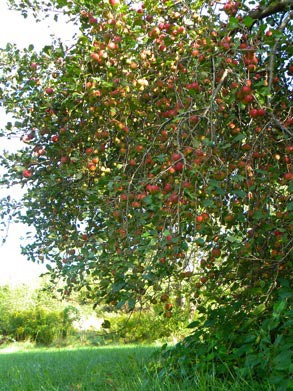Soon after the ice storm in January 1998, I passed through an apple orchard on my way uphill to an ice-shattered woodlot. The birches surrounding the orchard were bent into, the maples were a terrible mess of broken branches, some on the ground, some dangling helplessly from the trees, but the apple trees looked as though nothing had happened. They were loaded with ice but suffered no damage. I looked at them in astonishment for a few minutes before it dawned on me that this is exactly what they are designed to do: carry a huge amount of weight. They don’t grow tall and they don’t grow fast and they’ll lose every battle with a maple or birch in the forest. But out here in the open, you can load them up with as much ice as you like and they’ll just wait patiently for it to melt.
I’m reminded of this now as everywhere the apple trees are loaded with fruit. Again, it looks impossible, both from a nutritional and an engineering standpoint. It sent me back to looking at Design in Nature, by Claus Mattheck, a wonderful book. It must be pretty good, because I love it even though I can only understand a small fraction of it.
The overall message is that trees and other things in nature, such as bones, illustrate what Mattheck calls “biomechanical self-optimization of shape.” With minimum weight, they achieve maximum strength. When he asks his sophisticated computer to design something to hold a lot of leaves and keep them in the sun, the computer comes up with a tree. And when the computer is given a structure that leans, it corrects the lean just as a tree does, using reaction wood and a slow progression back to a vertical position. When light is available off to the side, leaning isn’t necessarily a mistake, for all trees must balance the sometimes competing needs of standing up straight and seeking light.
According to Mattheck, both the apple and the maple are designed so that stress is uniformly distributed. This “axiom of uniform stress” means that stress acts uniformly over the surface of all components; as a result, all loads are evenly distributed. When stress is distributed in this way, there are no locally excessive stresses and all areas are fully loaded – which means there’s no wasted material.
Before too long, the trees will shed their heavy apple loads. But at the moment, they stand as shining examples of biomechanical self-optimization.



Discussion *